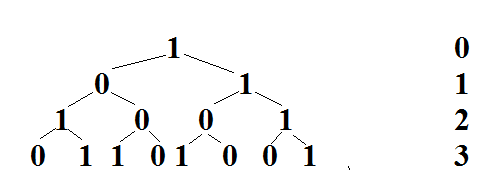A sequence consisting of one digit, the number 1 is initially written into a computer. At each successive time step, the computer simultaneously tranforms each digit 0 into the sequence 1 0 and each digit 1 into the sequence 0 1. So, after the first time step, the sequence 0 1 is obtained; after the second, the sequence 1 0 0 1, after the third, the sequence 0 1 1 0 1 0 0 1 and so on.
How many pairs of consequitive zeroes will appear in the sequence after n steps?
Input
Every input line contains one natural number n (0 < n ≤1000).
Output
For each input n print the number of consecutive zeroes pairs that will appear in the sequence after n steps.
Sample Input
2
3
Sample Output
1
1
分析:
题意:
如果根节点是1 则左右子节点分别是0、1,如果根节点是0则左右子节点分别是1、0,现在给出根节点是一个数字1,问,第n次变换产生多少对00?

解析:
经过分析发现,数字1经过两次变换后会出现一对00,然后就是一对00经过两次变换后出现一对00,那么我们用sum[N]数组记录这一次变换有多少个1产生,dp[N]数组记录这次变换有多少对00产生!
于是我们写出状态转移方程为:
dp[i]=dp[i-2]+sum[i-2];
但是,你发现没有?输入n的最大取值是1000,sum[1000]=sum[999]*2;
dp[1000]=dp[998]+sum[998];经过一次变化有1个1,二次变化有2个1,三次就是4个1,数字1的数量是按指数级增长的,指数达到30就不得了了,更何况1000呢?
所以这里还要大数算法!
代码写出来之后,我们发现sum[i-2]+dp[i-2]==dp[i-1]+2*dp[i-2];这样我们就可以再减少sum[N]数组部分数据的处理!
代码:
#include<iostream>
#include<cstdio>
#include<algorithm>
#define N 1005
using namespace std;
int dp[N][N];
int main()
{
int n;
dp[0][0]=dp[1][0]=dp[2][0]=dp[2][1]=1;
dp[0][1]=dp[1][1]=0;
for(int i=3;i<=1000;i++)
{
int temp=max(dp[i-1][0],dp[i-2][0]),v=0;
for(int j=1;j<=temp;j++)
{
dp[i][j]=2*dp[i-2][j]+dp[i-1][j]+v;
v=dp[i][j]/10;
dp[i][j]%=10;
}
dp[i][0]=temp;
while(v!=0)
{
dp[i][0]++;
dp[i][temp+1]=v%10;
v/=10;
}
}
while(~scanf("%d",&n))
{
for(int i=dp[n][0];i>0;i--)
{
printf("%d",dp[n][i]);
}
printf("\n");
}
return 0;
}
